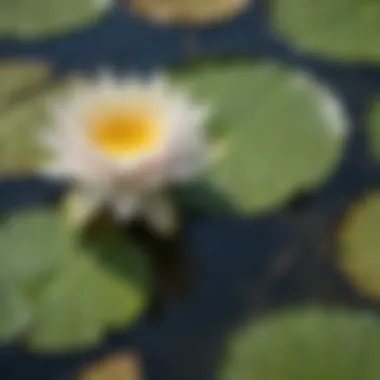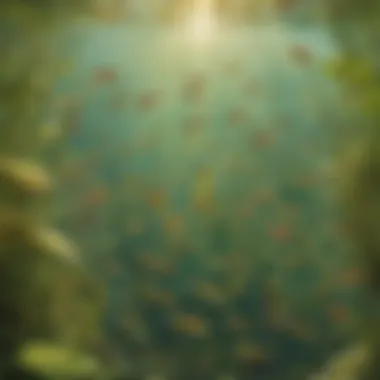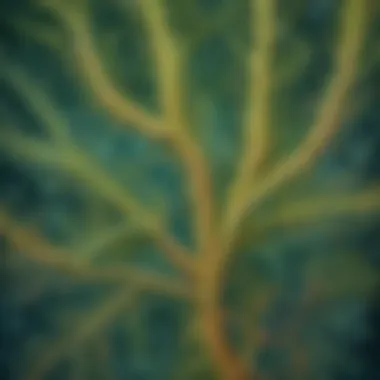Unveiling the Enigmatic World of Pond Ecosystems: A Diverse Tapestry of Life


Science Fun Facts
In the captivating realm of pond ecosystems, you'll encounter a plethora of marvels that astonish and intrigue. Did you know that a teaspoon of pond water may contain millions of microscopic organisms? These tiny beings play a monumental role in the ecosystem's balance, unseen yet indispensable. Have you ever heard of the marbled newt, a fascinating amphibian that gracefully navigates through pond waters? Its intricate patterns and adaptive abilities make it a true wonder of nature. Dive into the world of pond ecosystems, where every droplet holds a story waiting to be uncovered.
Discover the Wonders of Science
Embark on a journey through the scientific marvels lurking beneath the serene surface of pond ecosystems. Explore how photosynthesis, the process by which plants convert sunlight into energy, sustains life in these aquatic habitats. Delve into the mesmerizing dance of predator and prey, as dragonfly nymphs stealthily hunt mosquito larvae in a delicate balance of survival. Unravel the magical transformation of tadpoles into frogs, a poignant tale of growth and adaptation in the heart of nature's embrace.
Science Quiz Time
Engage your curious minds with interactive challenges designed to test your knowledge of pond ecosystems. Can you identify the primary producers in a pond ecosystem? A. Phytoplankton B. Frogs C. Snails D. Earthworms Put your thinking caps on and unravel the mysteries of the underwater world through brain-teasing quizzes. How does the process of decomposition contribute to nutrient recycling in ponds? Dive into the depths of scientific inquiry and emerge victorious as a champion of pond knowledge!
Science Experiment Showcase
Immerse yourself in the world of experimental discovery with hands-on activities that bring pond ecosystems to life. Experiment with pond water samples to observe microscopic organisms under a microscope, unlocking a hidden realm teeming with life. Follow step-by-step instructions to create a mini-ecosystem in a jar, complete with plants, snails, and algae, mimicking the intricate balance of a natural pond. Explore the scientific method through engaging experiments that foster a love for exploration and discovery in the young minds of tomorrow.
Introduction to Pond Ecosystems
Diving into the realm of pond ecosystems provides a captivating journey into a world teeming with life and interconnectedness. In this article, we will unravel the intricate web of flora and fauna that thrives within these aquatic habitats. Understanding the significance of pond ecosystems is crucial in appreciating the delicate balance that supports life in these watery realms. By exploring the nooks and crannies of pond life, we unveil a mesmerizing tapestry of biodiversity that awaits curious minds.
Defining Ponds
Ponds, these serene bodies of water, are defined by their shallow depth and still waters, distinguishing them from swiftly flowing rivers and vast oceans. These aquatic ecosystems play a vital role in supporting diverse species of plants and animals, creating a unique environment for life to flourish. The characteristics of ponds make them dynamic ecosystems, harboring a plethora of organisms that contribute to the overall balance and sustainability of the habitat.
Importance of Pond Ecosystems
The importance of pond ecosystems extends far beyond their tranquil surface. These biodiverse habitats serve as vital sources of freshwater, supporting a myriad of aquatic life forms. Additionally, ponds play a crucial role in maintaining ecological balance by serving as breeding grounds for various species, thereby contributing to the overall health of surrounding ecosystems. Understanding and preserving the significance of pond ecosystems is key to ensuring the sustainability of not just these bodies of water but the interconnected biodiversity they support.
Characteristics of Pond Environments
Pond environments possess unique characteristics that set them apart from other aquatic habitats. From the diversity of plant life to the array of creatures that call ponds home, these ecosystems exhibit a delicate balance of interactions. Factors such as water depth, sunlight penetration, and nutrient levels shape the ecological dynamics of ponds, influencing the distribution and abundance of flora and fauna. Exploring the various features of pond environments unveils a world where every detail plays a crucial role in sustaining life within these watery ecosystems.


Flora in Pond Ecosystems
Flora in pond ecosystems plays a crucial role in the intricate web of life that thrives within these aquatic environments. The presence of aquatic plants not only adds to the beauty of ponds but also serves essential functions that support the overall ecosystem dynamics. These plants provide oxygen, food, and shelter to a myriad of organisms, ranging from microscopic creatures to larger vertebrates. Understanding the diversity and significance of flora in pond ecosystems is vital to appreciating the delicate balance that exists within these biodiverse habitats.
Aquatic Plants
Submerged Plants
Submerged plants are a fundamental component of pond ecosystems, with their roots firmly planted in the underwater soil. Their ability to thrive entirely submerged in water sets them apart from other types of aquatic vegetation. Submerged plants play a crucial role in oxygenating the water, absorbing excess nutrients, and providing hiding places for small fish and invertebrates. Although they lack the flashy blooms of emergent plants, their understated nature makes them essential contributors to the overall health of pond ecosystems.
Floating Plants
Floating plants, as the name suggests, drift on the surface of the water, creating a picturesque scene in ponds. Their unique adaptations allow them to stay afloat, with roots hanging below to extract nutrients from the water. These plants provide shade, reducing sunlight penetration and regulating water temperature. While their rapid growth may lead to occasional overpopulation issues, their ability to cover large areas of the pond's surface makes them valuable in preventing algae blooms and providing habitat for various aquatic species.
Emergent Plants
Emergent plants stand tall at the water's edge, with roots submerged and stems rising above the surface. These plants play a vital role in stabilizing shorelines, preventing erosion, and offering refuge to nesting birds and amphibians. Their intricate root systems filter pollutants, making the water cleaner and clearer. Despite their beneficial qualities, emergent plants require careful maintenance to prevent overcrowding and maintain a balanced ecosystem.
Plant Adaptations to Pond Life
Adaptations are key for plants to thrive in pond environments where water levels fluctuate, and competition for sunlight and nutrients is high. Aquatic plants have developed specialized structures to cope with these challenges, such as flexible stems to withstand water currents, air-filled tissues for buoyancy, and efficient oxygen transport systems. These adaptations enable them to photosynthesize efficiently and outcompete other plants for resources in their watery habitat. Understanding these unique adaptations provides insights into the resilience and survival strategies of pond vegetation in ever-changing conditions.
Fauna In Pond Ecosystems: The fauna in pond ecosystems play a vital role in maintaining the delicate balance of life within these aquatic habitats. From microscopic organisms to vertebrates, each species contributes uniquely to the richness and diversity of pond ecosystems. By understanding the importance of fauna in pond ecosystems, we gain insight into the interconnected web of life that thrives within these watery havens.
Microscopic Organisms:
Protozoa:
Protozoa form a fundamental part of the pond ecosystem, serving as essential primary consumers in the aquatic food web. Their role in breaking down organic matter and recycling nutrients is crucial for sustaining the ecosystem's health. Protozoa's ability to thrive in diverse environmental conditions makes them a resilient and adaptable choice for studying pond ecosystems. Despite their microscopic size, Protozoa exhibit remarkable diversity and specialize in various ecological niches within the pond environment.
Algae:
Algae, another group of microscopic organisms, contribute significantly to nutrient cycling and oxygen production in pond ecosystems. Their photosynthetic capabilities not only support other aquatic life but also help maintain water clarity by competing with harmful algae species. Algae's rapid growth rate and ability to adapt to varying nutrient levels make them a key player in regulating the ecological balance of pond ecosystems.


Invertebrates:
Crustaceans:
Crustaceans, such as freshwater shrimp and crayfish, are essential invertebrates that influence nutrient cycling and serve as prey for various vertebrates in pond ecosystems. Their exoskeletons provide protection against predators, while their scavenging behavior helps clean up decaying matter, contributing to ecosystem cleanliness. Crustaceans' diverse feeding habits and roles as both herbivores and detritivores make them integral components of the pond food web.
Insects:
Insects, ranging from aquatic beetles to dragonflies, are ubiquitous inhabitants of pond ecosystems with diverse ecological functions. They serve as pollinators, predators, and prey, playing a crucial role in regulating insect populations and controlling algae growth. Insects' adaptability to different water conditions and their importance in nutrient cycling make them valuable indicators of pond ecosystem health.
Vertebrates:
Fish:
Fish are prominent vertebrates in pond ecosystems, contributing to both food webs and recreational activities such as fishing. Their foraging behavior helps control invertebrate populations, while serving as prey for larger predators like birds and reptiles. The diverse fish species found in ponds exemplify the intricate relationships and dependencies that characterize these aquatic environments.
Amphibians:
Amphibians, including frogs and salamanders, are indicators of environmental quality and health in pond ecosystems. They rely on both aquatic and terrestrial habitats, making them sensitive to changes in water quality and habitat destruction. Amphibians' permeable skin and complex life cycles highlight their vulnerability to environmental stressors, emphasizing the importance of conservation efforts to protect their populations.
Reptiles:
Reptiles, such as turtles and snakes, contribute to the biodiversity and predator-prey dynamics of pond ecosystems. Their presence influences insect populations and contributes to nutrient cycling through their feeding habits. Reptiles' adaptation to diverse environments and their roles as both predators and prey underscore their significance in maintaining the ecological balance of pond ecosystems.
Interactions in Pond Ecosystems
The topic of interactions in pond ecosystems is of paramount significance within the context of this article on exploring life in a pond. These interactions encompass a web of relationships between various organisms that inhabit this intricate ecosystem. From microscopic organisms like protozoa to larger vertebrates such as fish and amphibians, the interconnectedness and interdependence within a pond ecosystem are essential for its sustainability. By elucidating the dynamics of these interactions, we can unravel the delicate balance that dictates the health and productivity of pond environments. Moreover, understanding these interactions sheds light on the ways in which different species rely on each other for survival, shaping the biodiversity and overall resilience of the pond ecosystem.
Food Chains and Webs
In the complex tapestry of a pond ecosystem, food chains and webs play a crucial role in delineating the flow of energy and nutrients among various organisms. A food chain illustrates the linear transfer of energy from one organism to another, starting from producers like aquatic plants to consumers such as small invertebrates and finally ending with top predators like fish. On the other hand, a food web is a more intricate concept that represents multiple interconnected food chains within the ecosystem. These interconnected pathways reveal the complexity of trophic interactions in ponds, showcasing the diversity of feeding relationships that sustain life within the ecosystem. By exploring food chains and webs, we can appreciate the intricate balance that dictates the survival and population dynamics of organisms in a pond habitat.


Adaptations for Survival
Survival in a pond ecosystem necessitates a myriad of adaptations from its inhabitants to thrive in this unique environment. From physiological adaptations like gills in fish for underwater respiration to behavioral adaptations like nocturnal foraging in certain invertebrates, organisms in ponds have evolved diverse strategies to cope with the challenges of their surroundings. These adaptations not only enhance the survival chances of individual species but also contribute to the overall resilience and stability of the ecosystem as a whole. By examining these adaptations, we can gain insight into the remarkable diversity of life forms in pond ecosystems and appreciate the ingenuity with which they have evolved to conquer environmental challenges.
Human Impact on Pond Ecosystems
Despite their natural balance, pond ecosystems are increasingly facing threats from human activities. Pollution, habitat destruction, and the introduction of non-native species are just a few examples of how human actions can disrupt the delicate equilibrium of pond environments. Understanding the impact of human interventions is crucial in mitigating these risks and preserving the biodiversity and functionality of pond ecosystems. By recognizing our role in these ecosystems, we can take steps towards sustainable conservation practices that ensure the longevity of these invaluable habitats for future generations.
Seasonal Changes in Pond Life
Delving into the intricate world of pond ecosystems, the seasonal changes play a pivotal role in the perpetuation of life within these serene water bodies. Understanding the seasonal variations in pond life not only provides insight into the dynamic nature of these ecosystems but also sheds light on the delicate balance that sustains the diverse flora and fauna. In this section, we will explore the importance of seasonal changes in pond life, highlighting the specific elements, benefits, and considerations that contribute to the dynamic nature of pond ecosystems.
Winter Dormancy
During the chilly embrace of winter, ponds undergo a transformative period of dormancy. As temperatures plummet and ice blankets the surface, many organisms retreat into a state of hibernation or dormancy to survive the harsh conditions. Winter dormancy is a crucial adaptation for pond life, allowing organisms to conserve energy and endure the cold winter months. In this subsection, we will delve into the adaptations and survival strategies employed by various organisms during winter dormancy, unraveling the mysteries of life beneath the frozen surface.
Spring Renewal
As winter loosens its grip and spring breathes new life into the world, ponds undergo a remarkable period of renewal. Spring marks the awakening of dormant organisms, the emergence of new life, and the bustling activity as pond ecosystems spring back to life. From amphibians mating to plants blooming, spring renewal is a time of rejuvenation and regeneration in pond habitats. In this section, we will examine the significance of spring renewal in pond ecosystems, elucidating the intricacies of this vibrant season of change.
Summer Abundance
With the arrival of summer's warmth, ponds teem with abundant life and activity. The long days and balmy temperatures create ideal conditions for the flourishing of diverse flora and fauna. Summer abundance in pond ecosystems showcases the peak of biological productivity, as organisms thrive in the rich aquatic environment. From vibrant plant growth to bustling animal activity, summer heralds a period of plenty and vitality in pond life. This subsection will delve into the intricacies of summer abundance, exploring the diverse life forms and interactions that define this vibrant season.
Fall Transition
As summer fades into autumn, ponds undergo a period of transition and change. The lush greenery begins to wane, temperatures cool, and organisms prepare for the upcoming winter dormancy. Fall transition in pond ecosystems symbolizes a shifting of gears, a time of preparation for the impending colder months. From migratory birds to changing plant colors, fall transition brings a sense of transformation and adaptation to pond life. In this section, we will unravel the nuances of fall transition in pond ecosystems, showcasing the beauty and significance of this transitional season.
Conservation of Pond Habitats
In the realm of pond ecosystems, the Conservation of Pond Habitats stands as a paramount imperative. As we delve into the intricate interconnections of life within ponds, it becomes evident that preserving these habitats is not merely a choice but a necessity for ecological balance. Conservation efforts play a pivotal role in safeguarding the delicate web of interactions that sustain the diverse flora and fauna within pond environments. By protecting pond habitats, we aim to maintain biodiversity, support numerous species, and safeguard crucial ecosystems. A holistic approach to conservation involves not only safeguarding the physical pond environment but also addressing the larger context of human impact and interconnected ecosystems.
Preservation Efforts
Preservation efforts encompass a wide array of strategies aimed at maintaining the natural sanctity of pond habitats. These initiatives may range from habitat restoration projects to invasive species control measures. By restoring degraded ponds and wetlands, we can revitalize crucial habitats for various aquatic species. Invasive species management plays a vital role in preserving the native biodiversity of ponds by mitigating the threats posed by non-indigenous flora and fauna. Additionally, educating the community about the significance of pond ecosystems and engaging in conservation activities enhance awareness and foster a sense of stewardship among individuals.
Importance of Biodiversity
The significance of biodiversity in pond ecosystems cannot be understated. Biodiversity plays a pivotal role in maintaining the ecological balance within ponds, ensuring resilience to environmental changes and promoting sustainability. The diverse array of species inhabiting pond environments contributes to intricate food webs, nutrient cycling, and overall ecosystem stability. Preserving biodiversity in ponds not only safeguards individual species but also upholds the integrity of entire ecosystems. By recognizing the importance of biodiversity, we acknowledge the intrinsic value of every living organism within pond habitats and the interconnectedness that sustains life in these fascinating ecosystems.







